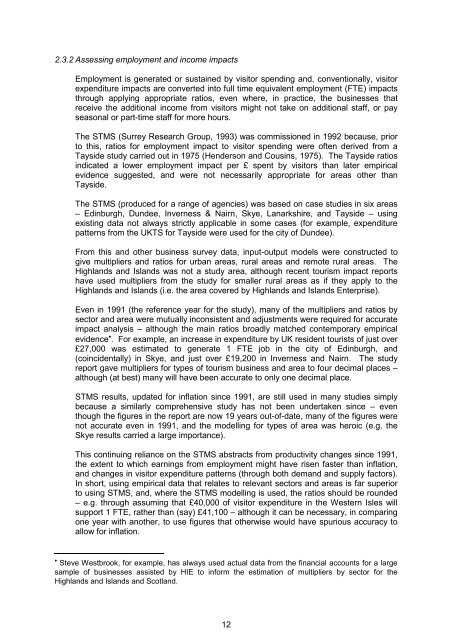Assessing the economic impacts of nature based tourism in Scotland
Assessing the economic impacts of nature based tourism in Scotland
Assessing the economic impacts of nature based tourism in Scotland
You also want an ePaper? Increase the reach of your titles
YUMPU automatically turns print PDFs into web optimized ePapers that Google loves.
2.3.2 <strong>Assess<strong>in</strong>g</strong> employment and <strong>in</strong>come <strong>impacts</strong><br />
Employment is generated or susta<strong>in</strong>ed by visitor spend<strong>in</strong>g and, conventionally, visitor<br />
expenditure <strong>impacts</strong> are converted <strong>in</strong>to full time equivalent employment (FTE) <strong>impacts</strong><br />
through apply<strong>in</strong>g appropriate ratios, even where, <strong>in</strong> practice, <strong>the</strong> bus<strong>in</strong>esses that<br />
receive <strong>the</strong> additional <strong>in</strong>come from visitors might not take on additional staff, or pay<br />
seasonal or part-time staff for more hours.<br />
The STMS (Surrey Research Group, 1993) was commissioned <strong>in</strong> 1992 because, prior<br />
to this, ratios for employment impact to visitor spend<strong>in</strong>g were <strong>of</strong>ten derived from a<br />
Tayside study carried out <strong>in</strong> 1975 (Henderson and Cous<strong>in</strong>s, 1975). The Tayside ratios<br />
<strong>in</strong>dicated a lower employment impact per £ spent by visitors than later empirical<br />
evidence suggested, and were not necessarily appropriate for areas o<strong>the</strong>r than<br />
Tayside.<br />
The STMS (produced for a range <strong>of</strong> agencies) was <strong>based</strong> on case studies <strong>in</strong> six areas<br />
– Ed<strong>in</strong>burgh, Dundee, Inverness & Nairn, Skye, Lanarkshire, and Tayside – us<strong>in</strong>g<br />
exist<strong>in</strong>g data not always strictly applicable <strong>in</strong> some cases (for example, expenditure<br />
patterns from <strong>the</strong> UKTS for Tayside were used for <strong>the</strong> city <strong>of</strong> Dundee).<br />
From this and o<strong>the</strong>r bus<strong>in</strong>ess survey data, <strong>in</strong>put-output models were constructed to<br />
give multipliers and ratios for urban areas, rural areas and remote rural areas. The<br />
Highlands and Islands was not a study area, although recent <strong>tourism</strong> impact reports<br />
have used multipliers from <strong>the</strong> study for smaller rural areas as if <strong>the</strong>y apply to <strong>the</strong><br />
Highlands and Islands (i.e. <strong>the</strong> area covered by Highlands and Islands Enterprise).<br />
Even <strong>in</strong> 1991 (<strong>the</strong> reference year for <strong>the</strong> study), many <strong>of</strong> <strong>the</strong> multipliers and ratios by<br />
sector and area were mutually <strong>in</strong>consistent and adjustments were required for accurate<br />
impact analysis – although <strong>the</strong> ma<strong>in</strong> ratios broadly matched contemporary empirical<br />
evidence • . For example, an <strong>in</strong>crease <strong>in</strong> expenditure by UK resident tourists <strong>of</strong> just over<br />
£27,000 was estimated to generate 1 FTE job <strong>in</strong> <strong>the</strong> city <strong>of</strong> Ed<strong>in</strong>burgh, and<br />
(co<strong>in</strong>cidentally) <strong>in</strong> Skye, and just over £19,200 <strong>in</strong> Inverness and Nairn. The study<br />
report gave multipliers for types <strong>of</strong> <strong>tourism</strong> bus<strong>in</strong>ess and area to four decimal places –<br />
although (at best) many will have been accurate to only one decimal place.<br />
STMS results, updated for <strong>in</strong>flation s<strong>in</strong>ce 1991, are still used <strong>in</strong> many studies simply<br />
because a similarly comprehensive study has not been undertaken s<strong>in</strong>ce – even<br />
though <strong>the</strong> figures <strong>in</strong> <strong>the</strong> report are now 19 years out-<strong>of</strong>-date, many <strong>of</strong> <strong>the</strong> figures were<br />
not accurate even <strong>in</strong> 1991, and <strong>the</strong> modell<strong>in</strong>g for types <strong>of</strong> area was heroic (e.g. <strong>the</strong><br />
Skye results carried a large importance).<br />
This cont<strong>in</strong>u<strong>in</strong>g reliance on <strong>the</strong> STMS abstracts from productivity changes s<strong>in</strong>ce 1991,<br />
<strong>the</strong> extent to which earn<strong>in</strong>gs from employment might have risen faster than <strong>in</strong>flation,<br />
and changes <strong>in</strong> visitor expenditure patterns (through both demand and supply factors).<br />
In short, us<strong>in</strong>g empirical data that relates to relevant sectors and areas is far superior<br />
to us<strong>in</strong>g STMS, and, where <strong>the</strong> STMS modell<strong>in</strong>g is used, <strong>the</strong> ratios should be rounded<br />
– e.g. through assum<strong>in</strong>g that £40,000 <strong>of</strong> visitor expenditure <strong>in</strong> <strong>the</strong> Western Isles will<br />
support 1 FTE, ra<strong>the</strong>r than (say) £41,100 – although it can be necessary, <strong>in</strong> compar<strong>in</strong>g<br />
one year with ano<strong>the</strong>r, to use figures that o<strong>the</strong>rwise would have spurious accuracy to<br />
allow for <strong>in</strong>flation.<br />
• Steve Westbrook, for example, has always used actual data from <strong>the</strong> f<strong>in</strong>ancial accounts for a large<br />
sample <strong>of</strong> bus<strong>in</strong>esses assisted by HIE to <strong>in</strong>form <strong>the</strong> estimation <strong>of</strong> multipliers by sector for <strong>the</strong><br />
Highlands and Islands and <strong>Scotland</strong>.<br />
12

















